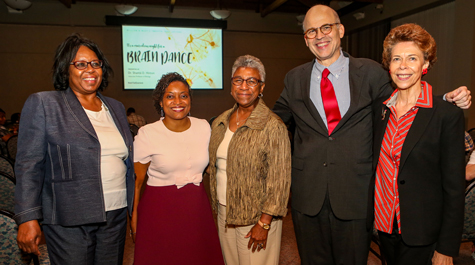Shantá Hinton’s Tack Lecture was a marvelous night for science and celebration
The evening of Oct. 4 was, as promised, a marvelous night.
It began and ended with music. In between, there was a whole lot of sophisticated biochemistry going on during the presentation titled “It’s A Marvelous Night for a Brain Dance, So Grab On, Hold On, like MK-STYX.”
Shantá D. Hinton gave William & Mary’s 12th Tack Faculty Lecture, leading a full house at Commonwealth Auditorium through an introduction to her work that was heavy on audience interaction.
{{youtube:medium:left|3zxww-NmgyE}}
Carl Tack ’78, who with his wife Martha ’78 endowed the Tack Faculty Lectures, was in attendance. In introducing Hinton, university Provost Michael Halleran said the lectures embrace a fundamental principle: “Namely, that our intellectual energy as a university comes primarily from the creative work of the faculty as they conduct research and lead students into a deeper understanding and in a quest for new knowledge.”
Hinton is an associate professor in William & Mary’s Department of Biology. Her research focuses on a curious protein called MK-STYX. Tack Lectures attract a general audience, so Hinton guided her listeners up a gentle ramp into her biochemical world.
She displayed the Periodic Table of the Elements on the screen behind her and led the audience in a call-and-response assembly of hydrogen and oxygen into the compound H2O. On the next slide she highlighted element number 15: phosphorus. She explained that her lab is interested in phosphorus compounds and their role in protein behavior.
“This is a protein. If we add this phosphate to a protein, this protein is called phosphorylated,” she explained. Enzymes known as kinases add phosphates, she said, while phosphates are removed by enzymes known as phosphatases. Hinton followed the explanation with another call and response.
“What protein adds a phosphate?” she asked the audience.
“Kinases!”
“What removes it?”
“Phosphatases!”
Hinton said that phosphatases, the phosphorus-removing enzymes, are an emerging field of study.
“There are more of you in this room than there are people working on phosphatases,” she said. “There are just about 180 of us.”
Phosphorylation or de-phosphorylation changes a protein’s functionality — or lack of function. PTPs — protein tyrosine phosphatases — are implicated in a number of diseases. She put up a slide with a grim list of what can happen when phosphorylation goes wrong: several varieties of cancer, lupus, rheumatoid arthritis, multiple sclerosis, even schizophrenia and psoriasis.
Hinton’s object of study is MK-STYX, a protein that is like a phosphatase that can’t quite get its phosphate-removal job done. MK-STYX will “grab on and hold on,” as in the lecture title, but does not actually delete the phosphate group.
The peculiar behavior of MK-STYX puts it among a group of proteins known a pseudophosphatases, she said. Hinton added that MK-STYX had been a bit of a sleeper in the world of protein-function research.
But, she told the audience, MK-STYX may not remove phosphate groups from proteins, a fact of cellular life that doesn’t mean MK-STYX is without function.
“And,” she said, “it’s my lab’s job to figure out its role.”
For one thing, her research has found that MK-STYX decreases the number and size of stress granules inside the cell that inhibit — a means of protection — the activity of mRNA — messenger RNA — whose job is to transfer genetic information necessary for protein synthesis from the DNA.
“But when it’s a stressful day for that cell, what happens? This messenger RNA is stalled, and they aggregate together and form what we call these stress granules,” she said.
Hinton said that MK-STYX reduced the presence of stress granules in HeLa cells and made a brief digression to explain the origin of “HeLa” cells.
“Now I need to take a brief moment to talk to you about HeLa cells, because 66 years ago, Henrietta Lacks died on exactly this day,” she said, displaying an image of the cover of the book The Immortal Life of Henrietta Lacks.
Lacks, who died of cervical cancer, had “an immortal cell line,” Hinton said. Doctors at Johns Hopkins harvested cervical cells from Lacks that are still being used in research today, and Hinton said the same immortal cell line is being used in her lab.
Her lab also found that MK-STYX has a role in neuronal development. Using cells from an area above a rat’s kidney.
“The reason we use these particular cells is that they’re boring,” Hinton said. “They’re just plain, round cells. But if you add a stimulus such as nerve growth factor, they become these cells with extensions.”
The extensions or outgrowths, she explained, are call neurites — predecessor structures of neurons. MK-STYX is particularly good at spurring outgrowths from the plain, boring round cells, and even has a role in neuron development.
Hinton peppered her talk with shouts-out. She noted that her presentation was a part of the 50th anniversary of residential African-American students at William & Mary. Lynn Briley, Janet Brown Strafer and Karen Ely, members of the class of 1971 were all sitting together at the Tack Lecture. They are the three women who were the first African-American students to live in residence halls and take full advantage of William & Mary’s facilities. Hinton asked each to stand, amid vigorous applause.
Hinton also reminded the audience that William & Mary will celebrate 100 years of co-education next year.
Collaborators on Hinton’s research, especially students, were recognized as well. She called a number of students up to the front of Commonwealth Auditorium and made a point of mentioning the names of student co-authors on the series of peer-reviewed journal papers produced by her lab.
She wrapped up her discussion of MK-STYX by asking why should anyone care about her work, then answering her own question.
“The truth is, from the very beginning, we already have our genes and certain proteins that may be very relevant,” Hinton said. “And it’s still a puzzle to us.”
She put up a slide listing a number of neurological disorders: memory loss, Alzheimer’s, dementia, confusion, delusions, Parkinson’s. Protein-based problems in cellular signaling could lead to such maladies and understanding how proteins interact is a necessary step to treatment and prevention.
Hinton ended on a personal note, showing a photo of herself, with a fresh Ph.D., sitting in the lap of her Alzheimer’s-stricken grandfather, while the sound system played his favorite song, the Staple Singers’ “I’ll Take You There.”
















